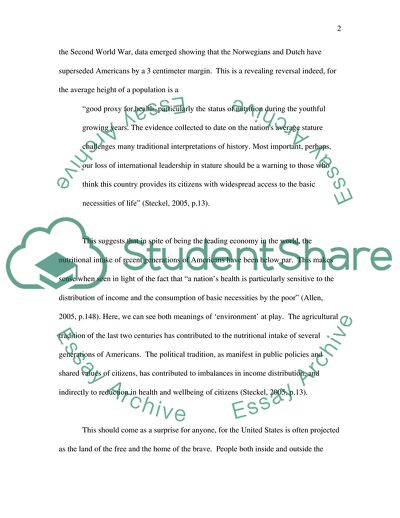
- Home
- Free Samples
- Premium Essays
- Editing Services
- Extra Tools
- Essay Writing Help
- About Us
- Studentshare
- Subjects
- Miscellaneous
- Environmental Economics
Environmental Economics - Essay Example
The relation…

- Subject: Miscellaneous
- Type: Essay
- Level: Ph.D.
- Pages: 4 (1000 words)
- Downloads: 0
- Author: oconnellbrain
Extract of sample "Environmental Economics"
Apart from the literal sense of the word, ‘environment’ could also be taken to mean the political and socio-cultural context of a particular geographic space. This essay attempts to address the aforesaid correlation from both these perspectives. Examples from recent and far history of the United States are used in support of arguments, while also making relevant references to the rest of the world. Statistics from eighteenth century shows that Americans had been the tallest people in the world at that time.
For example, Americans averaged 172 centimeters in 1750, a clean seven centimeters taller than their Anglo-Saxon brethren across the Atlantic. But since then, the difference has steadily declined and eventually reversed, making Americans shorter than their European counterparts. In the decades following the Second World War, data emerged showing that the Norwegians and Dutch have superseded Americans by a 3 centimeter margin. This is a revealing reversal indeed, for the average height of a population is a “good proxy for health, particularly the status of nutrition during the youthful growing years.
The evidence collected to date on the nations average stature challenges many traditional interpretations of history. Most important, perhaps, our loss of international leadership in stature should be a warning to those who think this country provides its citizens with widespread access to the basic necessities of life” (Steckel, 2005, p.13). This suggests that in spite of being the leading economy in the world, the nutritional intake of recent generations of Americans have been below par. This makes sense when seen in light of the fact that “a nation’s health is particularly sensitive to the distribution of income and the consumption of basic necessities by the poor” (Allen, 2005, p.148). Here, we can see both meanings of
...Download file to see next pages Read MoreCHECK THESE SAMPLES OF Environmental Economics
Environmental Economics Analysis
Principles of Environmental Economics
Contemporary Policy Environmental Economics
Environmental economics. Article review 4
ENVIRONMENTAL ECONOMICS assignment
Environmental Economics Issues
Environmental- Economics Case Study
The Environmental Economics Way

- TERMS & CONDITIONS
- PRIVACY POLICY
- COOKIES POLICY